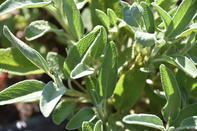Sage originates from Southern Europe and the Mediterranean Asian countries. There are close to a thousand different types and cultivars of Salvia or sage plants.

For the purpose of commercial production, there are two main types that are produced or harvested and are often mixed together either intentionally or by accident due to their similarity.
Scientific name: Salvia officinalis
Common Name: Common Sage or Dalmatian Sage
Being the most popular with the strongest aroma and oil characteristics for which, the herb is cultivated.
And
Scientific name: Salvia Triloba
Common Name: Mediterranean Sage or Wild Sage
Cultivated mainly in Europe and grows wild there.
Plant Description
The Sage plant is semi-hardy and can grow to about 700 mm in height. The plant is an evergreen shrub that has grey-green leaves that have a silvery sheen to them. They produce blue, purple or white flowers.
Uses
Sage in both its fresh form and dried is used in many food dishes as a flavouring. The other use is for the production of essential oils. The leaves have the highest quality oils and both dried sage and the oils are used extensively in the processed meat industry as flavouring and a preservative. It is considered an antioxidant and is also used by the perfume industry as an insect repellent. Sage has a wide range of purported health and curative abilities like for the symptoms of colds and flu, for example, a sore throat and fever. Sage tea is said to sooth the pains from a fever.
Soil Requirements and Preparation
Sage does best in well-drained loam soils and grows in a wide pH range of between 5 and 8 but does best in soils with a pH of between 6.5 and 7. Before any soil preparation is done a representative soil sample should be taken and sent to a laboratory for analysis and nutrient recommendations.
Soils should then be ripped to loosen the soil profile to about 600 mm to ensure good drainage. The lime for possible pH rectifying and the manure or compost should be applied and ploughed into the top 400 mm of soil about four to five weeks before planting. In the final days before planting add the required trace elements and a balanced pre-plant fertiliser to the soil and disc harrow or rotavator into the top 20 cm of soil. This clears any weeds that may have established. If ridging and mulching are done then these are also done at this stage and the seedbeds are now prepared for planting.
Climate
Sage is a hardy, evergreen plant that grows in drier temperate climates and performs best in temperatures of between 20°C and 30°C. It is also tolerant to frost and in temperate winters will over-winter well. Excessive cold does, however, kill the plant unless protected.
Cultivars
There are two main types of Sage harvested commercially, Common Sage and Mediterranean Sage.
The cultivars most commonly planted for human consumption are: Alba, Albiflora, Aurea, Berggarten, Extrakta, Icterina, Lavandulaefolia, Purpurascens, Purpurea and Tricolor.